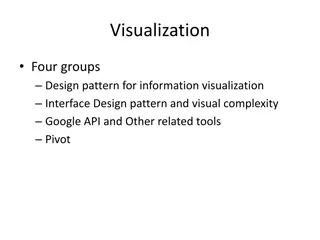Understanding Design Patterns in Software Development
Learn about design patterns in software development, including creational patterns like Singleton, Factory, and Builder. Discover how design patterns provide solutions to common programming problems, increase code flexibility, and improve program design. Gain insights into the concepts of Singleton pattern with examples of eager and lazy initialization. Explore the significance of sharing, interning, and flyweight patterns in Java constructors.
Uploaded on Sep 21, 2024 | 0 Views
Download Presentation

Please find below an Image/Link to download the presentation.
The content on the website is provided AS IS for your information and personal use only. It may not be sold, licensed, or shared on other websites without obtaining consent from the author. Download presentation by click this link. If you encounter any issues during the download, it is possible that the publisher has removed the file from their server.
E N D
Presentation Transcript
Section 8: Design Patterns Slides by Alex Mariakakis with material from David Mailhot, Hal Perkins, Mike Ernst
Announcements HW8 due tonight 10 pm Quiz 7 due tonight 10 pm Industry guest speaker tomorrow! Topic: Tech Interviews Room change: GUG 220 (the large lecture hall next to our normal room)
What Is A Design Pattern A standard solution to a common programming problem A technique for making code more flexible Shorthand for describing program design and how program components are connected
Creational Patterns Problem: Constructors in Java are not flexible o Always return a fresh new object, never reuse one o Can t return a subtype of the class they belong to Solution: Creational patterns! o Sharing Singleton Interning Flyweight o Factories Factory method Factory object o Builder
Creational Patterns: Sharing The old way: Java constructors always create a new object Singleton: only one object exists at runtime Interning: only one object with a particular (abstract) value exists at runtime Flyweight: separate intrinsic and extrinsic state, represents them separately, and interns the intrinsic state
Singleton For a class where only one object of that class can ever exist Ensure a class has only one instance, and provide a global point of access to it. -- GoF, Design Patterns Two possible implementations o Eager initialization: creates the instance when the class is loaded to guarantee availability o Lazy initialization: only creates the instance once it s needed to avoid unnecessary creation
Singleton Eager initialization public class Bank { private static Bank INSTANCE = new Bank(); // private constructor private Bank() { } // factory method public static Bank getInstance() { return INSTANCE; } } Bank b = new Bank(); Bank b = Bank.getInstance();
Singleton Lazy initialization public class Bank { private static Bank INSTANCE; // private constructor private Bank() { } // factory method public static Bank getInstance() { if (INSTANCE == null) { INSTANCE = new Bank(); } return INSTANCE; } } Bank b = new Bank(); Bank b = Bank.getInstance();
Singleton Would you prefer eager or lazy instantiation for an HTTPRequest class? o handles authentication o definitely needed for any HTTP transaction Would you prefer eager or lazy instantiation for a Comparator class? o compares objects o may or may not be used at runtime
Singleton public class HttpRequest { private static class HttpRequestHolder { public static final HttpRequest INSTANCE = new HttpRequest(); } /* Singleton Don t instantiate */ private HttpRequest() { } public static HttpRequest getInstance() { return HttpRequestHolder.INSTANCE; } }
Singleton public class LengthComparator implements Comparator<String> { private int compare(String s1, String s2) { return s1.length()-s2.length(); } /* Singleton Don t instantiate */ private LengthComparator() { } private static LengthComparator comp = null; public static LengthComparator getInstance() { if (comp == null) { comp = new LengthComparator(); } return comp; } }
Interning Similar to Singleton, except instead of just having one object per class, there s one object per abstract value of the class Saves memory by compacting multiple copies
Interning public class Point { private int x, y; public Point(int x, int y) { this.x = x; this.y = y; } public int getX() { return x; } public int getY() { return y; } @Override public String toString() { return ( + x + , + y + ) ; } }
Interning public class Point { private static Map<String, Point> instances = new HashMap<String, Point>(); public static Point getInstance(int x, int y) { String key = x + , , + y; if (!instances.containsKey(key)) instances.put(key, new Point(x,y)); return instances.get(key); } private final int x, y; // immutable private Point(int x, int y) { } } Requires the class being interned to be immutable. Why?
Interning What if Points were represented in polar coordinates? What further checks are necessary to make sure these kinds of Points are interned correctly?
Interning public class Point { private static Map<String, Point> instances = new HashMap<String, Point>(); public static Point getInstance(double r, double theta) { double normalizedTheta = normalize(theta); String key = r + , + normalizedTheta; if (!instances.containsKey(key)) instances.put(key, new Point(r, normalizedTheta)); return instances.get(key); } private final double r, theta; // immutable private Point(double r, double theta) {...} } Why do we need to normalize?
Summary: Sharing Patterns The old way: Java constructors always create a new object Singleton: only one object exists at runtime Interning: only one object with a particular (abstract) value exists at runtime Flyweight: separate intrinsic and extrinsic state, represents them separately, and interns the intrinsic state
Factories Suppose we want a constructor for Set that takes a list as a parameter, and produces a TreeSet if the list is sorted, and a HashSet otherwise. Is this possible?
Factories Factories solve the problem that Java constructors cannot return a subtype of the class they belong to Two options: o Factory method A method that creates and returns objects Method defines the interface for creating an object, but defers instantiation to subclasses o Factory object Abstract superclass defines what can be customized Concrete subclass does the customization, returns appropriate subclass
Factory Method public static Set produceSet(List list) { if (isSorted(list)) { return new TreeSet(list); } else { return new HashSet(list); } }
Factory Object interface SetFactory { Set getSet(); } class HashSetFactory implements SetFactory { public Set getSet() { return new HashSet(); } }
Builder The class has an inner class Builder and is created using the Builder instead of the constructor The Builder takes optional parameters via setter methods (e.g., setX(), setY(), etc.) When the client is done supplying parameters, she calls build() on the Builder, finalizing the builder and returning an instance of the object desired Useful when you have many constructor parameters o It is hard to remember which order they should all go in Easily allows for optional parameters o If you have n optional parameters, you need 2^n constructors, but only one builder
Builder public class NutritionFacts { private final int servingSize, servings; // required private final int calories, fat, sodium; // optional // all the contructors! public NutritionFacts(int srvSize, int servings) { this(srvSize, servings, 0); } public NutritionFacts(int srvSize, int servings, int cal) { this(srvSize, servings, cal, 0); } public NutritionFacts(int srvSize, int servings, int cal, int fat) { this(srvSize, servings, cal, fat, 0); } ... public NutritionFacts(int srvSize, int servings, int calories, int fat, int sodium) { this.servingSize = srvSize; this.servings = servings; this.calories = calories; this.fat = fat; this.sodium = sodium; } }
Builder public class NutritionFacts { private final int servingSize, servings, calories, fat, sodium; // inner builder class public static class Builder { private int servingSize, servings; // required private int calories = 0, fat = 0, sodium = 0; // optional public Builder(int servingSize, int servings) { this.servingSize = servingSize; this.servings = servings; } public Builder calories(int val) { calories = val; return this; } public Builder fat(int val) { fat = val; return this; } public Builder sodium(int val) { sodium = val; return this; } public NutritionFacts build() { return new NutritionFacts(this); } } // only one constructor public NutritionFacts(Builder builder) { this.servingSize this.servings this.calories this.fat this.sodium } = builder.servingSize; = builder.servings; = builder.calories; = builder.fat; = builder.sodium; }
Builder public class NutritionFacts { private final int servingSize, servings, calories, fat, sodium; // inner builder class public static class Builder { private int servingSize, servings; // required private int calories = 0, fat = 0, sodium = 0; // optional public Builder(int servingSize, int servings) { this.servingSize = servingSize; this.servings = servings; } public Builder calories(int val) { calories = val; return this; } public Builder fat(int val) { fat = val; return this; } public Builder sodium(int val) { sodium = val; return this; } public NutritionFacts build() { return new NutritionFacts(this); } } // only one constructor public NutritionFacts(Builder builder) { this.servingSize this.servings this.calories this.fat this.sodium } why return this (rather than void) from these methods? = builder.servingSize; = builder.servings; = builder.calories; = builder.fat; = builder.sodium; }
Structural Patterns Problem: Sometimes difficult to realize relationships between entities o Important for code readability Solution: Structural patterns! o We re just going to talk about wrappers, which translate between incompatible interfaces Purpose Pattern Functionality Interface Adapter same different modify the interface Decorator different same extend behavior Proxy same* same restrict access *from client s perspective
Adapter Changes an interface without changing functionality o Rename a method o Convert units Examples: o Angles passed in using radians vs. degrees o Bytes vs. strings
Decorator Adds functionality without changing the interface o Add caching Adds to existing methods to do something additional while still preserving the previous spec o Add logging Decorators can remove functionality without changing the interface o UnmodifiableList with add() and put()
Proxy Wraps the class while maintaining the same interface and functionality Integer vs. int, Boolean vs. boolean Controls access to other objects o Communication: manage network details when using a remote object o Security: permit access only if proper credentials o Creation: object might not yet exist because creation is expensive
Activity Adapter, Builder, Decorator, Factory, Flyweight, Intern, Model-View- Controller (MVC), Proxy, Singleton, Visitor, Wrapper What pattern would you use to o add a scroll bar to an existing window object in Swing o We have an existing object that controls a communications channel. We would like to provide the same interface to clients but transmit and receive encrypted data over the existing channel.
Activity Adapter, Builder, Decorator, Factory, Flyweight, Intern, Model-View- Controller (MVC), Proxy, Singleton, Visitor, Wrapper What pattern would you use to o add a scroll bar to an existing window object in Swing Decorator o We have an existing object that controls a communications channel. We would like to provide the same interface to clients but transmit and receive encrypted data over the existing channel. Proxy
Announcements HW8 due tonight 10 pm Quiz 7 due tonight 10 pm Guest speaker tomorrow! Topic: Tech Interviews! Lecture in GUG 220 (the large lecture hall next door to our normal room)























